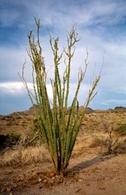 Growing Ocotillo - July 20, 2016 Jeff Schalau, Agent, Agriculture & Natural Resources University of Arizona Cooperative Extension, Yavapai County Ocotillo (Fouquieria splendens) is a unique native desert plant with low-branching, spiny, canes. Ocotillos can grow over 15 feet in height and as wide. In spring, it is topped with bright orange-red, tubular flowers. They are typically leafless most of the year, but produce many leaves after receiving substantial precipitation. When the soil dries, ocotillos quickly shed their leaves to reduce evaporative loss and conserve plant moisture. Ocotillos are extremely drought tolerant and an excellent accent plant for residential and commercial landscapes. Ocotillo’s native range includes the Sonoran and Chihuahuan deserts from Baja, California eastward to the Trans-Pecos in Texas and south to Zacatecas, Mexico. Ocotillos are also native to some areas of the Verde Valley where they are found on south-facing gentle to moderate slopes. This is likely due to their need for well-drained soils, heat, and relative intolerance of prolonged low temperatures. Ocotillos will tolerate temperatures down to 10 degrees F. For planting in the Verde Valley area, I would suggest trying to find a warm site with well-drained soils. Ocotillos are available from selected nurseries. Many of these are salvaged plants that either come from construction areas in Arizona or are collected in other states (many are from Texas). However, ocotillos are protected native plants and may not be legally possessed, taken or transported from the growing site without a permit from the Arizona Department of Agriculture. Ocotillos can be transplanted year round by knowledgeable people, but greatest success is achieved during March through May. Like cacti and other succulents, ocotillos should be transplanted to the original growing depth and in their original directional orientation. The original south side of the plant, which receives more heat and is more sunlight-resistant, should again face the hotter southern direction. Well drained sandy or gravelly loam soils favor ocotillo root development. People transplanting ocotillos should dig the planting hole wide enough to accommodate the root system and no deeper than the root system. After digging the planting hole, check for drainage by filling the hole with water. If the hole drains within an hour, it is suitable for planting ocotillo. Do not use organic amendments in the backfill. Broken or damaged roots should be cleanly pruned and allowed to dry for a week prior to planting. Container grown plants do not require any root pruning prior to planting. Care should be taken to minimize air pockets in the backfill material. The Desert Botanical Garden of Phoenix, AZ recommends adding 30% coarse sand to existing backfill. They also recommend soaking the root system with a solution of rooting hormone prior to planting (see additional resources below). Work dry soil in amongst the roots of bare root plants to ensure that the backfill is in contact with the roots. There should be no need to use stakes or guys even though the plant is placed very shallow in the soil. However, if there is a potential for blow down on bare root plants, consider using large stones placed 6 inches or so away from the trunk to support the canes until they root. It’s not necessary, nor recommended, that the tops of ocotillo plants be pruned back when transplanting. Too much irrigation following transplanting can kill ocotillos. In most cases, ocotillos should be irrigated weekly at a minimum during the summer months and twice per month during the winter. Once established (you will know when they leaf out routinely and start to flower which may take anywhere from 6 to 24 months) then you can begin to reduce supplemental irrigation. Most established ocotillos do not require any supplemental water during the cooler months and certainly no more than every second to fourth week during the hottest of summers. You can tell if the plant is still alive by checking the canes to see if they are still pliable and have a greenish color to them. Containerized plants should become established at a much faster rate than bare root plants. Transplanted ocotillos require patience, but once established, these beautiful plants will enhance the landscape for many years. Follow the Backyard Gardener on Twitter – use the link on the BYG website. If you have other gardening questions, call the Master Gardener help line in the Camp Verde office at 928-554-8992 or e-mail us at verdevalleymg@gmail.com and be sure to include your name, address and phone number. Find past Backyard Gardener columns or provide feedback at the Backyard Gardener web site: http://cals.arizona.edu/yavapai/anr/hort/byg/. Additional Resources Cactus, Agave, Yucca and Ocotillo University of Arizona Cooperative Extension extension.arizona.edu/pubs/az1225.pdf Planting a Bare Root Ocotillo Desert Botanical Garden www.dbg.org/sites/dbg.dd/files/planting_ocotillo.pdf |